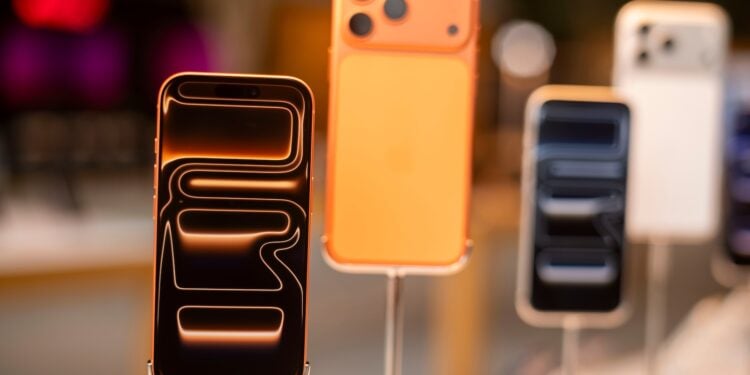With the iPhone 17 series and iPhone Air, Apple introduces a front-facing camera that fundamentally changes the way you take selfies and record videos. The 18-megapixel Center Stage camera combines a novel square sensor design with automatic rotation and zoom adjustment, making mobile photography easier and more flexible than ever before.
The front camera is one of the most important features of a smartphone for many users. With the iPhone 17, Apple has redesigned this component and introduced a system that performs more than conventional selfie cameras. The square sensor captures more image data, while the Center Stage feature automatically adjusts the image composition to the situation. Whether alone or in a group, the camera delivers a perfect result without manual intervention.
A revolutionary sensor design
The front camera sensor is significantly different from previous models. Instead of rectangular, it's square, capturing a larger area of the image. This allows for flexible post-processing within the device without compromising image quality. The 18 megapixels also deliver a high level of detail, which is evident in both photos and videos.
Automatic rotation and dynamic zoom
The Center Stage feature reacts in real time to changes in the image framing. The camera automatically switches between portrait and landscape mode without having to rotate the iPhone 17 in your hand. At the same time, it adjusts the zoom:
- For a single face, the image is framed more closely to create a personal feeling.
- As more people join, the section automatically expands so that no one is cut off.
This system ensures that selfies and group shots are always in the correct format.
Take photos with Center Stage
Using the new front camera remains straightforward. After opening the camera app, simply tap the icon with the circular arrows in the bottom right corner to switch to selfie mode. The Center Stage button appears above the viewfinder as a profile icon in the frame. When it glows yellow, the function is active. The shot is then automatically aligned before the shutter button is pressed.
Manual control of the camera
Even though the automatic system takes over a lot of things, the option for manual control remains.
- There is a separate symbol in the viewfinder for rotating between portrait and landscape format.
- The zoom can be individually adjusted using the arrow symbol inwards and outwards.
This ensures full control at all times if automatic adjustment is not desired.
Turn off automatic rotation
Sometimes the automatic rotation can be distracting, for example, when faces are detected in the background that shouldn't be part of the selfie. In this case, simply tap the yellow Center Stage button. Next to "Auto-rotate," you can set the option to "Off." After that, the orientation remains stable and can only be changed manually.
Turn off automatic zoom
The automatic zoom function also has the option to be turned off. You can also select "Off" for "Auto Zoom" using the Center Stage button. The field of view can then be adjusted manually using the zoom button in the viewfinder.
Center Stage at FaceTime
This feature isn't limited to the camera app. Even during FaceTime calls, the face always remains in focus. The system tracks movements in the image and ensures a stable and professional display, similar to iPads and MacBooks, which already use this technology.
iPhone 17 Camera: Progress in Selfies and Video Chats
The iPhone 17 brings a significant advancement with its center-stage front camera. The square sensor offers more flexibility and better quality, while automatic rotation and zoom simplify everyday life. At the same time, the option for manual control is retained, allowing every shot to achieve the desired effect. Whether for selfies, group photos, or video calls – the iPhone 17's front camera sets new standards and clearly demonstrates how much Apple has evolved mobile photography. Looking for accessories? Our Amazon Storefront is your destination for high-quality products, including HomeKit-compatible ones! (Image: Shutterstock / Ringo Chiu)
- iPhone 17 Dual Capture explained: Using the front and rear cameras
- iOS 26 Screenshot Disable full screen and enable old view
- iPhone 17: Disable or customize the camera control button
- iPhone Tip: Live Translation in Messages, Phone & FaceTime
- iOS 26: Filter messages, block spam & keep track
- Setting up your iPhone correctly: Check, block, and filter calls
- Keep an eye on your blood pressure: How the iPhone Health app helps
- Apple explains Apple Watch high blood pressure warnings
- Setting up Apple Music transitions: AutoMix or Crossfade
- macOS 26: Automatically connect iPhone hotspot
- watchOS 26: Why the Apple Watch sometimes charges slowly
- iOS 26: Reduce transparency for more clarity
- Find and adjust the camera flash in iOS 26 – here's how
- iOS 26 makes Adaptive Power the norm on the iPhone 17 series
- iOS 26 Tip: Unlock iPhone with Apple Vision Pro
- iOS 26: The most important tips for setup and use
- iOS 26: Impact on battery life after the update
- iOS 26: Use spatial scenes directly in the Photos app
- iOS 26 Update: Markdown Import and Export in Notes Explained
- iOS 26: Easily change backgrounds in iMessage
- iOS 26: Trigger iPhone camera with AirPods – here's how
- How to enable transparent iPhone app icons with iOS 26
- iOS 26: Apple Music finally gets folders for playlists
- iOS 26: Capture reminders faster and easier
- Apple Music in iOS 26: Music Pins make access easier
Frequently Asked Questions about the iPhone 17 front camera with Center Stage
The iPhone 17's front camera has 18 megapixels and uses a new square sensor for more image information and better quality.
Center Stage automatically adjusts the frame and orientation. The camera zooms in and out to ensure optimal selfies and videos.
Yes. In the camera app, you can use the Center Stage button to turn off automatic rotation and select the format manually.
Auto zoom can be deactivated using the Center Stage button. Afterward, the image section can be controlled manually using the zoom symbol.
Yes. With FaceTime, Center Stage automatically keeps the face in focus and tracks movement to ensure a stable and professional presentation.
The iPhone 17's square sensor captures more image data than rectangular sensors, allowing flexible image composition without loss of quality.





